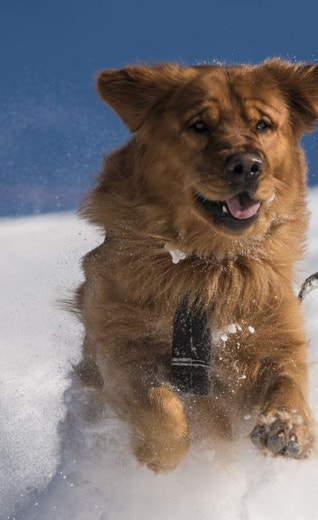
How Much To Feed Your Active Dog For The Adventures Ahead
Since 1969, Eukanuba™ has focused on developing nutrition for active, sporting and working dogs. While you don’t need a PhD to feed your dog, there are some important steps to follow. Here are some helpful dog feeding tips from the research scientists at Eukanuba’s™ innovative Pet Health and Nutrition Center.
- Assess your dog’s current body condition. To figure how much to feed your dog, start with an analysis of his body condition and weight. Here’s how to evaluate your dog’s body condition:
- Rib check: Ideally you should easily feel your dog’s ribs when your fingers are held flat against his rib cage. If you need to use your fingertips to find the ribs then your dog is likely overweight. Visibly seeing your dog’s ribs generally means he’s underweight, with some exceptions as some dogs naturally have very lean body types. Examples of dogs that look thin but may be at the correct weight are greyhounds, English pointers, and the like.
- Waist check: Ideal weight means you should see a tuck starting where the chest ends and the hips begin. If the line from the bottom of the chest goes straight, then your dog is probably overweight. If there is a big hollow area your dog might be too thin. There should be a visible waist.
- Hip check: If you can clearly see hip bones then your dog is too thin. If there are bulges on either side he may be overweight.
Chart out your dog’s daily caloric needs. Next, determine your dog’s daily caloric needs. Scientists use a formula to determine a dog’s basic daily caloric needs. It’s a two-step calculation.
- First, divide a dog’s body weight in pounds by 2.2 to convert it to kilograms.
- Then, raise the dog’s weight in kilograms to the ¾ power and multiply by 70.
- Here’s an example:
• A 44-pound dog’s weight divided by 2.2 means he weighs 20 kilograms.
• 20kg raised to the ¾ power x 70 = 662 kilocalories (kcals) that a dog needs to consume at a minimum every day.
Helpful calculator tip: You’ll need a calculator with an xy function. Key the converted kilogram weight (i.e. 20 from above example) into your calculator. Then press the xy function. Next, enter 0.75 for the ¾ power. Then multiply by 70. Your result should be 662 as noted in the example above.
- Factor in your dog’s daily activity level. The more active your dog is, the more calories he will need to consume. For active dogs involved in light work or exercise, their daily caloric need should be multiplied by 2. For active dogs working or exercising moderately, multiple the daily caloric need by 3. For dogs involved in heavy work or exercise, multiple the daily caloric need by up to 6.
Here's how it might look for a 44-pound dog:
• 662 times 2 = 1,324 calories per day for light work.
• 662 times 3 = 1,986 calories per day for moderate work.
• 662 times 6 = up to 3,972 calories per day for heavy work.
To figure out the number of cups to feed, take a look at your dog’s food label to find the kcals provided in each cup of food. Divide the number of calories your dog needs based on their activity level by the kcals per cup to determine the total cups needed per day. Also account for any treats you give your dog. Treats should make up no more than 10% of a dog’s total daily calories.
- Select a diet that matches your dog’s activities and energy needs. A dog with an active lifestyle can benefit greatly from a performance diet formulated for the extra demands on their body. Since active dogs require more energy from their food, a tailored blend of protein, carbohydrates and fat is key to help maximize their potential.
In addition, dogs sprinting after a disc or through an agility course need a different ratio of these energy sources than dogs on a long trail run. Sprint activities are considered anaerobic and require immediate energy that comes from a higher amount of carbohydrates that can be efficiently absorbed by your dog’s digestive system. When dogs exercise for a longer period of time, they are working aerobically and require sustained energy that comes from a higher amount of fat.
By matching your dog’s activity to an optimal dietary energy source, you help give him the kind of fuel he needs to help him perform at his peak. Consider feeding your dog a performance diet like Eukanuba’s Premium Performance range with four formulas tailored to varying levels of activities.
- Determine the best feeding time and amount. Highly active dogs should be fed two times a day. 1/3 of the daily food should be fed in the morning at least 3 hours before activities like running. It’s important that there be at least 3 hours in between feeding a meal and a big activity like running so a dog’s body can digest his food.
The remaining 2/3 of the food should be fed in the afternoon or evening at least two hours following their last run or similar activity. Those two hours allow for a rest and cooling off period. A dog’s core body temperature needs time to drop to a normal level before eating. Always provide fresh, clean water with each meal and throughout the day.
There’s more to feeding your dog than just pouring food into his bowl. Determine how much he needs to eat, match a type of energy to his activity level, and you’ll see a dog fueled to thrive every time you head outside.




